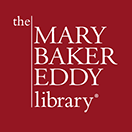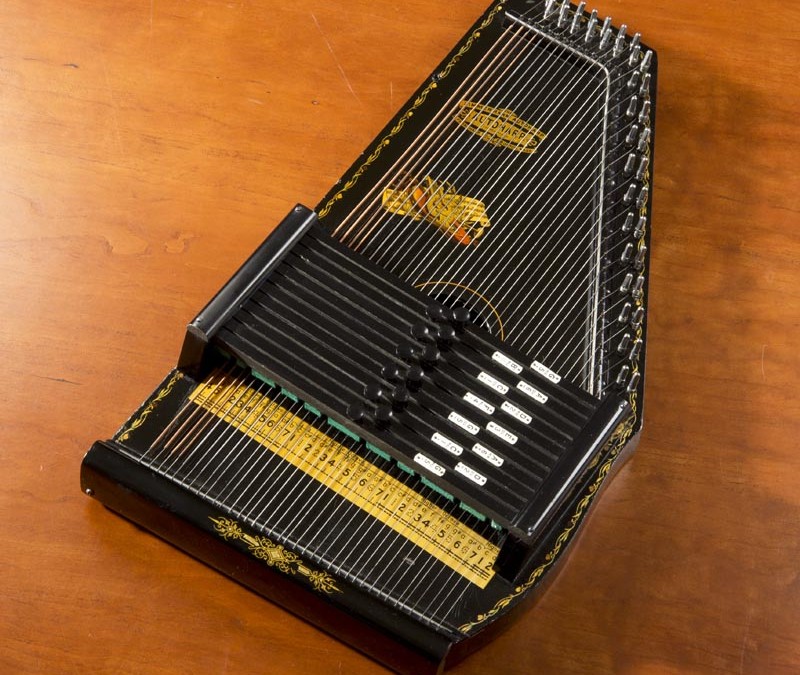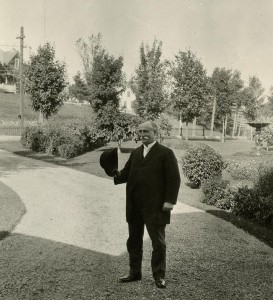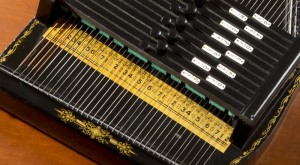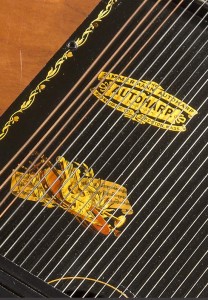Calvin Frye worked for Mary Baker Eddy longer than anyone else, as both a secretary and bookkeeper. His service from 1882 to 1910 (apparently with only one day of vacation!) is an incredible testament to his devotion to both Eddy and Christian Science, as well as to her appreciation of his talents.
After Eddy’s passing in December 1910, Frye suddenly found himself with more free time than he had had in decades. From his diaries our collection, we learn that he spent much of it relaxing. Frye played dominoes, billiards, and croquet. Additionally he went to the symphony, bowled, took in plays, and attended the movies almost on a weekly basis. He did many of these activities with friends and family. Frye frequently traveled, too, including tours of Europe and the western United States.
It was also at this time that Frye was able to take up playing some musical instruments. According to his nephew, Oscar H. P. Frye, his uncle “found time in later years to study a little instrument known as an autoharp.” He recalled, “I have heard him play on this…instrument, and he did very well indeed.” Frye had no children, and his nephew was heir to his estate. “I have quite a little music written up in his own hand,” he said, “which he evidently transcribed purposely into a form which he could use on this instrument.”1
The autoharp is a Zimmerman, made by the Phonoharp Company of East Boston, Massachusetts, circa 1910. Its dimensions in inches are 22 x 12 x 4. In 2018 the Library gifted it to Longyear Museum in Chestnut Hill, Massachusetts. The sheet music that his nephew mentions remains in our collection. Additionally, we have some finger picks that Frye would have used to play the instrument.
One dictionary notes that the autoharp is not technically a harp but a zither, which is defined as “a musical instrument that has strings stretched across a shallow wooden box and that is played with your fingers [on the right hand] or a pick.”2 An autoharp can be played on a table, against the left shoulder, or on one’s lap. At the same time that one strums the strings, the left hand presses buttons—these control bars that damp all strings except those of the selected chords.
Looking at Frye’s diary entries from 1911 to 1916, we learn a few things about his experiences with the autoharp. The first mention appears in October 1911, when Frye was told that he should contact Carl Behr about instruction on the “zither.” Behr was a German-born professional musician living in the Boston area,3 who played the cello with the Boston Symphony Orchestra and had also taken up the autoharp.4 While it’s unclear if Frye ever followed through on taking “zither” lessons, his diary does note many times when he practiced the instrument. It also notes one occasion when he repaired it and another when he tuned it himself (thereby saving himself a dollar). On another occasion, however, he had to go to East Boston and engage George Reynolds (whose occupation in the 1912 edition of the Boston City Directory was listed as “tuner”) to tune it for him. There is also a mention of his copying sheet music for the autoharp, some of which we have in our collection.
The history of the autoharp begins approximately 30 years before Frye’s instrument was made. A German citizen, Karl Gütter, invented the Akkordzither, and in 1882 a United States patent for the autoharp (similar to the Akkordzither) was granted to Charles Zimmerman. He started production of the autoharp in 1885 in Philadelphia, and over 50,000 of the instruments were sold in the first three years of production. Autoharp historian A. Doyle Moore notes, “Its fascination, however, was that of a toy rather than a serious musical contribution, and the new instrument continued for some time as a novelty in the gadget-happy Victorian period.”5
Zimmerman’s patent was later acquired by Alfred Dolge, a New York City piano equipment manufacturer. He distributed the autoharp by means of mail order and door-to-door sales all over the United States. Although Dolge’s sales increased, he spent more money on advertising, and problems with dealers and pricing led to the end of production by Dolge in the late 1890s.
Over the next decade, autoharp sales remained low. However, in 1910 the Phonoharp Company of East Boston, Massachusetts (from whom Frye would purchase his autoharp), obtained the rights and patents to build autoharps and ceased producing phonoharps (which were not nearly as popular). According to Moore, the company “…started tediously to re-establish the autoharp as a parlor instrument.” And “with only a modest catalog and house-to-house salesmen, The company succeeded because the appeal for the autoharp had moved from the privacy of the parlor to recreational gatherings, hospital wards, and classrooms.”6
That last point is especially important to note, because at this time period the playing of live music was a popular form of recreation. Radio did not yet exist, and recorded music (on cylinders and disks) was just beginning to become commonplace. An instrument such as the autoharp was easy to learn and good for entertaining guests.
For his part, Frye had less time for playing the autoharp when he took on the duties of First Reader at First Church of Christ, Scientist, Concord, New Hampshire, in 1913. He traveled twice a week between his home in Boston and Concord, spending a great deal of his time studying the Christian Science Bible Lessons. Even though we have entries from Frye’s diaries that go through the end of 1916, his last entry related to the autoharp is on February 1, 1914, when he mentions playing it in the evening.
While the autoharp was never extinct from the sphere of popular music, the instrument certainly didn’t reach any type of prominence again until the mid-twentieth century, when the Carter Family, a bluegrass performing group, brought about its revival. Today it is still played, primarily in bluegrass, folk, and country music.
For more information, check out this video of how to play the autoharp.
- SF – Frye, Oscar H. P. – Family History Materials.
- Merriam-Webster, s.v. “zither,” accessed March 31, 2014, http://www.merriam-webster.com/dictionary/zither
- “United States Census, 1900,” index and images, FamilySearch (https://familysearch.org/pal:/MM9.1.1/M9TN-1G3: accessed 29 May 2014), Carl Behr, Brookline town (west of St. Paul St. & north of Longwood Ave., Beacon St. & Summit Ave.), Norfolk County, Massachusetts, United States; citing sheet 23B, family 454, NARA microfilm publication T623, FHL microfilm 1240669.
- “Famed Musician Plans Residence on North Shore,” Wilmette Life (Wilmette, IL), September 24, 1926.
- A. Doyle Moore, “The Autoharp,” New York Folklore Quarterly, December 1963, 263.
- Moore, “The Autoharp,” 266
